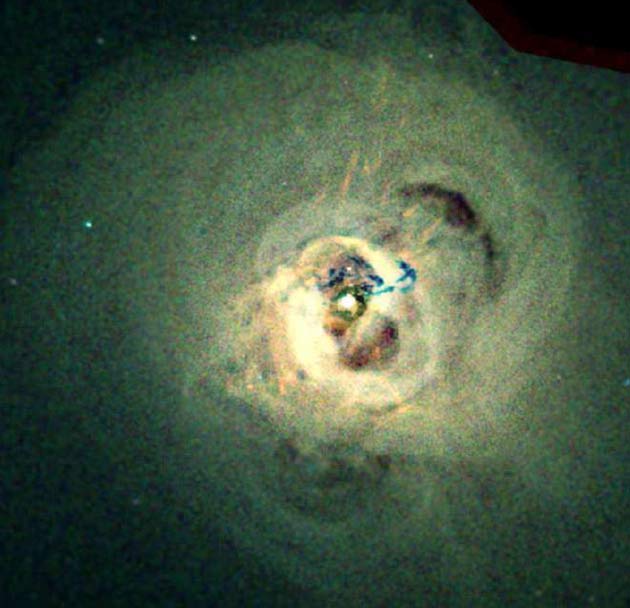Black Hole Makes Plumes that Span Intergalactic Space

Newfound plumes of material 300,000 light-years across are forced outward by the explosive venting of a supermassive black hole, astronomers announced today.
Observations by NASA's Chandra X-ray Observatory revealed the energetic plumes of particles associated with a massive galaxy cluster called Perseus. The results provide evidence that a black hole can influence the space around it to intergalactic distances, researchers said.
"In relative terms, it is as if a heat source the size of a fingernail affects the behavior of a region the size of Earth," said Andrew Fabian of Cambridge University.
Fabian is lead author of a report to be published in the Monthly Notices of the Royal Astronomical Society.
The Perseus cluster contains thousands of galaxies, all embedded in a giant cloud of superheated gas. The gas alone has the mass of trillions of suns.
The plumes, seen clearly in enhanced images from X-ray data, are low pressure regions in the hot gas extending outward from the central galaxy, NGC 1275, which is one of the largest galaxies in the universe. The low pressure is likely the result of the displacement of the gas by bubbles of unseen high-energy particles, Fabian's team reports.
The bubbles appear to be generated by high-speed jets that shoot out from the supermassive black hole anchoring NGC 1275. Individual bubbles in the inner regions expand and merge to create vast plumes at larger distances.
Get the Space.com Newsletter
Breaking space news, the latest updates on rocket launches, skywatching events and more!
Earlier this year, observations from the Hubble Space Telescope revealed bubbles blown in a similar fashion by the output of another black hole.
"The plumes show that the black hole has been venting for at least 100 million years, and probably much longer," said co-author Jeremy Sanders, also of Cambridge University.
The venting produces sound waves that heat the gas throughout the inner regions of the cluster and prevent the gas from cooling and making stars at a significant rate. This process has slowed the growth of NGC 1275, the astronomers said.
- A Galactic Collision with NGC 1275
- Black Hole Strikes Deepest Musical Note Ever Heard
- Giant Galaxy Clusters Collide, Evidence Shows
- A Cosmic Storm: When Galaxy Clusters Collide
Join our Space Forums to keep talking space on the latest missions, night sky and more! And if you have a news tip, correction or comment, let us know at: community@space.com.

Rob has been producing internet content since the mid-1990s. He was a writer, editor and Director of Site Operations at Space.com starting in 1999. He served as Managing Editor of LiveScience since its launch in 2004. He then oversaw news operations for the Space.com's then-parent company TechMediaNetwork's growing suite of technology, science and business news sites. Prior to joining the company, Rob was an editor at The Star-Ledger in New Jersey. He has a journalism degree from Humboldt State University in California, is an author and also writes for Medium.









